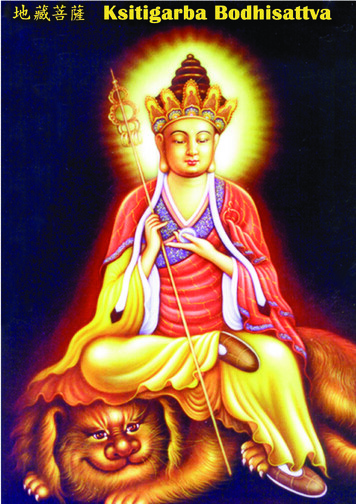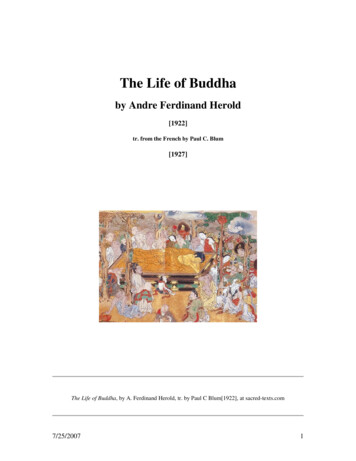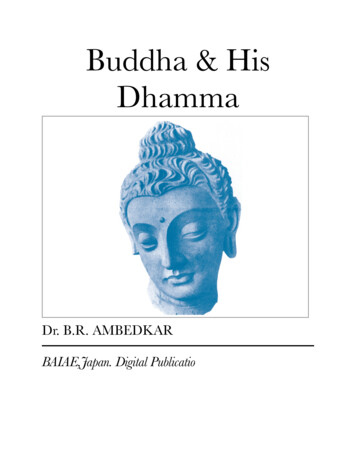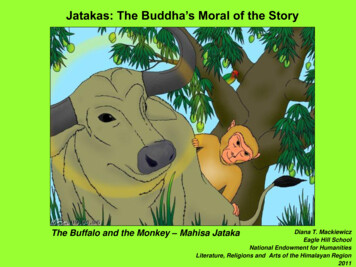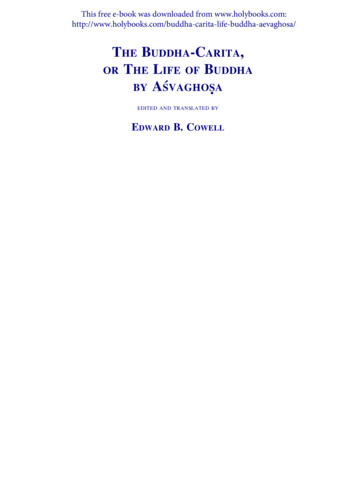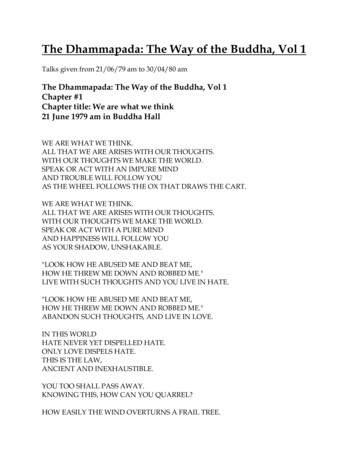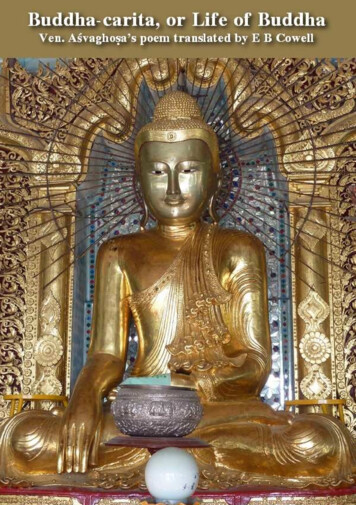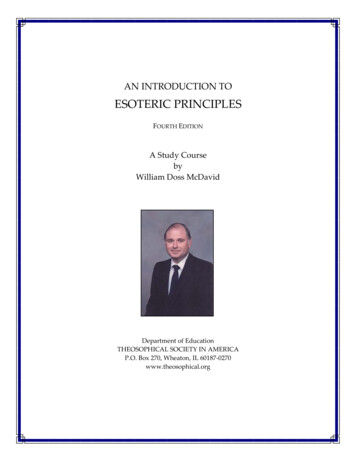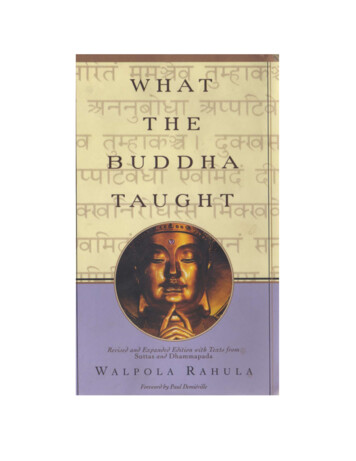
Transcription
Bhaisajja-guru. The Buddha as the Great Doctorfor the Ills of the World—from Japan
W A L P O L A SRI R A H U L ATripitakavagUvaracharyaWhat the Buddha Taught(Revised edition)With a Foreword byPAUL D E M I E V I L L Eanda collection of illustrative texts translated fromthe original Pali Grove PressNew York
Also by Walpola Sri RahulaHistory of Buddhism in CeylonThe Heritage of the BhikkhuCopyright 1959 by W. RahulaSecond and enlarged edition copyright 1974 by W. RahulaAll rights reserved. No part of this book may be reproduced in anyform or by any electronic or mechanical means, includinginformation storage and retrieval systems, without permission inwriting from the publisher, except by a reviewer, who may quotebrief passages in a review. Any members of educationalinstitutions wishing to photocopy part or all of the work forclassroom use, or publishers who would like to obtain permissionto include the work in an anthology, should send their inquiries toGrove/Atlantic, Inc., 841 Broadway, New York, NY 10003.Printed in the United States of AmericaLibrary of Congress Catalog Card Number: 73-21017ISBN 0-8021-3031-3Grove Press841 BroadwayNew York, NY 1000305 45 44 43 42 41 40 39L
ContentsList of IllustrationsForewordPreface - xiThe--BuddhaCHAPTER IPageviiixxvThe Buddhist Attitude of MindMan is supreme—One is one's refuge—Responsibility—Doubt—Freedom of Thought—Tolerance—Is Buddhism Religion or Philosophy?—Truth has no label—No blind faith or belief, but seeingand understanding—No attachment even to Truth—Parable of theraft—Imaginary speculations useless—Practical attitude—Parableof the wounded man - 1THE FOUR NOBLE TRUTHSCHAPTER IIThe First Noble Truth: DukkhaBuddhism neither pessimistic nor optimistic, but realistic—Meaningof 'Dukkha'—Three aspects of experience—Three aspects of'Dukkha'—What is a 'being'?—Five Aggregates—No spiritopposed to matter—Flux—Thinker and Thought—Has life abeginning? .16CHAPTER IIIThe Second Noble Truth: Samudaya: 'The Arising of Dukkha'—Definition—Four Nutriments—Root cause of suffering and continuity—Nature of arising and cessation—Karma and Rebirth—What is death?—What is rebirth?29The Third Noble Truth: Nirodha: 'The Cessation of Dukkha'—What is Nirvana?—Language and Absolute Truth—Definitions ofNirvana—Nirvana not negative—Nirvana as Absolute Truth—What is Absolute Truth?—Truth is not negative—Nirvana andSamsara—Nirvana not a result—What is there after Nirvana?—Incorrect expressions—What happens to an Arahant after death?—If no Self, who realises Nirvana?—Nirvana in this life .35CHAPTER IVCHAPTER vThe Fourth Noble Truth: Magga: 'The Path'Middle Path or Noble Eightfold Path—Compassion and Wisdom—Ethical Conduct—Mental Discipline—Wisdom—Two sorts ofUnderstanding—Four Functions regarding the Four Noble Truthsviii45
CHAPTER VIThe Doctrine of No-Soul: AnattaWhat is Soul or Self?—God and Soul: Self protection and Selfpreservation—Teaching 'Against the Current'—Analytical andSynthetical methods—Conditioned Genesis—Question of Free-will—Two kinds of Truths—Some erroneous views—The Buddha definitelydenies 'Atman'—The Buddha's silence—The idea of Self a vagueimpression—Correct attitude—If no Self, who gets the result ofKarma?—Doctrine of Anatta not negative.51CHAPTER VII'Meditation' or Mental Culture: BhavanaErroneous views—Meditation is no escape from life—Two forms ofMeditation—The Setting-up of Mindfulness—'Meditation' onbreathing—Mindfulness of activities—Living in the present moment—'Meditation' on Sensations—on Mind—on Ethical, Spiritual andIntellectual subjects. . . . . . 67CHAPTER VIIIWhat the Buddha Taught and the World TodayErroneous views—Buddhism for all—In daily life—Family andsocial life—Lay life held in high esteem—How to become a Buddhist—Social and economic problems—Poverty: cause of crime—Materialand spiritual progress—Four kinds of happiness for laymen—Onpolitics, war and peace—Non-violence—The ten duties of a ruler—The Buddha's Message—Is it practical?—Asoka's ExampleThe Aim of Buddhism76SELECTED TEXTS .9Setting in Motion the Wheel of Truth (Dhammacakkappavattanasutta)92The Fire Sermon (Adittapariyaya-sutta)95Universal Love (Metta-sutta)9798Blessings (Mahgala-sutta)Getting rid of All Cares and Troubles (Sabbasava-sutta) .99The Parable of the Piece of Cloth ( Vatthupama-suttd) . .106The Foundations of Mindfulness (Satipaffhana-sutta) . .109Advice to Sigala (Sigalovada-sutta)119The Words of Truth (.Dhammapada)125The Last Words of the Buddha (from the d Bibliography142Glossary.148Index .1VI
IllustrationsFRONTISPIECE1The Buddha as Bhaisajya-guru or Bhisakka in Pali texts (A. Colombo,Ed. p. 822), the Great Doctor for the Ills of the World. He holds thecasket of medicine in his left hand, raising his right hand in Abhayamudra, the symbol of safety and peace. Yakushi Nyorai. Wood.9th century A.C. Gango-Ji Temple, Japan. Photo: Bullo , Paris.BETWEEN PAGES 16 AND 17I. The bust of the Buddha. Bronze. Thailand. Sukhotai. About 14thcentury A.C. Musee Guimet, Paris. By courtesy of the Musee Guimet, Paris.II. The head of the colossal stone statue of the recumbent Buddha.Galvihara, Polonnaruva, Ceylon. 12th century A.C. By courtesy of Mrs.Mona de Mel.BETWEEN PAGES J2 AND })III. The interior of one of the cave temples at Dambulla, Ceylon.1st century B.C. The statues and paintings seen in the illustration areof later date. By courtesy of the Musee Guimet, Paris.IV. The Great Renunciation. Prince Siddhartha leaving his wife andchild and palace to become an ascetic in search of Truth. AnandaTemple, Pagan, Burma, n t h to 12th century A.C. By courtesy of theMusee Guimet, Paris.V. The Buddha. Mathura, India. 5 th Century A.C. Mathura Museum.By courtesy of the Musee Guimet, Paris.VI. The Buddha. Yun Kang style. China. End of the 5 th centuryA.C. Musee Guimet, Paris. By courtesy of the Musee Guimet, Paris.BETWEEN PAGES 48 AND 49VII. The Buddha showing the myrobalan fruit (or gem?) on hisright palm. Here is represented the significance of the expressionehi-passika 'come and see', which is used to describe his teaching—seep. 9. Bronze from Tibet. Musee Guimet, Paris. By courtesy of the MuseeGuimet, Paris.viii
VIII. Head of the Buddha. Hadda, Afghanistan. Stucco. GraecoIndian style, 3rd to 4th century A.C. Musee Guimet, Paris. By courtesyof the Musee Guimet, Paris.IX. The Buddha. Prah Khan, Cambodia. Khmer Art, Bayon style.12th century A.C. Musee Guimet, Paris. By courtesy of the Musee Guimet,Paris.X. Samsara-cakra or Bhava-cakra, the Cycle of Existence and Continuity. Tibet. Museum fur Volkerkunde, Hamburg. By courtesy of theMusee Guimet, Paris.between pages 64 and 65XI. Sujata offering milk-rice to the Buddha on the day of his Enlightenment. Borobudur, Java. 8th century A.C. By courtesy of the MuseeGuimet, Paris.XII. Head of the Buddha. Borobudur, Java. 8th century A.C.Museum, Leiden. By courtesy of the Musee Guimet, Paris.Xni. The Buddha in Dharmacakra-mudra, symbolizing preaching.Borobudur, Java. 8th century A.C. By courtesy of the Musee Guimet, Paris.XIV. The Parinirvana of the Buddha. Ajanta, India. Cave 26. 6thcentury A.C. By courtesy of the Musee Guimet, Paris.b e t w e e n p a g e s 80 a n d 8 iXV. The Buddha in Dharmacakra-mudra, symbolizing preaching.Sarnath, India. 5 th century A.C. By courtesy of the Musee Guimet, Paris.XVI. The Buddha. Borobudur, Java. 8th century A.C. By courtesy ofthe Musee Guimet, Paris.viii
ixForewordby Paul DemievilleMember of the Institut de France,Professor at the College de FranceDirector of Buddhist Studies at the Schoolof Higher Studies (Paris)Here is an exposition of Buddhism conceived in a resolutelymodem spirit by one of the most qualified and enlightenedrepresentatives of that religion. The Rev. Dr. W. Rahula receivedthe traditional training and education of a Buddhist monk inCeylon, and held eminent positions in one of the leading monasticinstitutes (Pirivena) in that island, where the Law of the Buddhaflourishes from the time of Asoka and has preserved all its vitalityup to this day. Thus brought up in an ancient tradition, he decided,at this time when all traditions are called in question, to face thespirit and the methods of international scientific learning. Heentered the Ceylon University, obtained the B.A. Honours degree(London), and then won the degree of Doctor of Philosophy of theCeylon University on a highly learned thesis on the History ofBuddhism in Ceylon. Having worked with distinguished professors at the University of Calcutta and come in contact with adeptsof Mahayana (the Great Vehicle), that form of Buddhism whichreigns from Tibet to the Far East, he decided to go into theTibetan and Chinese texts in order to widen his cecumenism,and he has honoured us by coming to the University of Paris(Sorbonne) to prepare a study of Asanga, the illustrious philosopher of Mahayana, whose principal works in the originalSanskrit are lost, and can only be read in their Tibetan and Chinesetranslations. It is now eight years since Dr. Rahula is among us,wearing the yellow robe, breathing the air of the Occident,searching perhaps in our old troubled mirror a universalizedreflection of the religion which is his.The book, which he has kindly asked me to present to thepublic of the West, is a luminous account, within reach of everybody, of the fundamental principles of the Buddhist doctrine, as
they are found in the most ancient texts, which are called 'TheTradition' (Agama) in Sanskrit and 'The Canonic Corpus'(Nikaja) in Pali. Dr. Rahula, who possesses an incomparableknowledge of these texts, refers to them constantly and almostexclusively. Their authority is recognized unanimously by all theBuddhist schools, which were and are numerous, but none ofwhich ever deviates from these texts, except with the intention ofbetter interpreting the spirit beyond the letter. The interpretationhas indeed been varied in the course of the expansion of Buddhismthrough many centuries and vast regions, and the Law has takenmore than one aspect. But the aspect of Buddhism here presentedby Dr. Rahula—humanist, rational, Socratic in some respects,Evangelic in others, or again almost scientific—has for its supporta great deal of authentic scriptural evidence which he only had tolet speak for themselves.The explanations which he adds to his quotations, alwaystranslated with scrupulous accuracy, are clear, simple, direct, andfree from all pedantry. Some among them might lead to discussion,as when he wishes to rediscover in the Pali sources all thedoctrines of Mahayana; but his familiarity with those sourcespermits him to throw new light on them. He addresses himself tothe modern man, but he refrains from insisting on comparisonsjust suggested here and there, which could be made with certaincurrents of thought of the contemporary world: socialism,atheism, existentialism, psycho-analysis. It is for the reader toappreciate the modernity, the possibilities of adaptation of adoctrine which, in this work of genuine scholarship, is presentedto him in its primal richness.
PrefaceAll over the world today there is growing interest in Buddhism.Numerous societies and study-groups have come into being, andscores of books have appeared on the teaching of the Buddha. Itis to be regretted, however, that most of them have been writtenby those who are not really competent, or who bring to their taskmisleading assumptions derived from other religions, which mustmisinterpret and misrepresent their subject. A professor of comparative religion who recently wrote a book on Buddhism didnot even know that Ananda, the devoted attendant of the Buddha,was a bhikk.hu (a monk), but thought he was a layman! Theknowledge of Buddhism propagated by books like these can beleft to the reader's imagination.I have tried in this little book to address myself first of all to theeducated and intelligent general reader, uninstructed in thesubject, who would like to know what the Buddha actuallytaught. For his benefit I have aimed at giving briefly, and asdirectly and simply as possible, a faithful and accurate account ofthe actual words used by the Buddha as they are to be found inthe original Pah texts of the Tipitaka, universally accepted byscholars as the earliest extant records of the teachings of theBuddha. The material used and the passages quoted here are takendirectly from these originals. In a few places I have referred tosome later works too.I have borne in mind, too, the reader who has already someknowledge of what the Buddha taught and would like to gofurther with his studies. I have therefore provided not only thePali equivalents of most of the key-words, but also references tothe original texts in footnotes, and a select bibliography.The difficulties of my task have been manifold: throughout Ihave tried to steer a course between the unfamiliar and thepopular, to give the English reader of the present day somethingwhich he could understand and appreciate, without sacrificinganything of the matter and the form of the discourses of theviii
Buddha. Writing the book I have had the ancient texts runningin my mind, so I have deliberately kept the synonyms and repetitions which were a part of the Buddha's speech as it has comedown to us through oral tradition, in order that the reader shouldhave some notion of the form used by the Teacher. I have kept asclose as I could to the originals, and have tried to make mytranslations easy and readable.But there is a point beyond which it is difficult to take an ideawithout losing in the interests of simplicity the particular meaningthe Buddha was interested in developing. As the title 'What theBuddha Taught' was selected for this book, I felt that it would bewrong not to set down the words of the Buddha, even the figureshe used, in preference to a rendering which might provide theeasy gratification of comprehensibility at the risk of distortionof meaning.I have discussed in this book almost everything which iscommonly accepted as the essential and fundamental teaching ofthe Buddha. These are the doctrines of the Four Noble Truths,the Noble Eightfold Path, the Five Aggregates, Karma, Rebirth,Conditioned Genesis (Paticcasamuppada), the doctrine of No-Soul{Anatta), Satipatthana (the Setting-up of Mindfulness). Naturallythere will be in the discussion expressions which must be unfamiliarto the Western reader. I would ask him, if he is interested, to takeup on his first reading the opening chapter, and then go on toChapters V, VII and VIII, returning to Chapters II, III, IV andVI when the general sense is clearer and more vivid. It wouldnot be possible to write a book on the teaching of the Buddhawithout dealing with the subjects which Theravada and MahayanaBuddhism have accepted as fundamental in his system of thought.The term Theravada—Hinayana or 'Small Vehicle' is no longerused in informed circles—could be translated as 'the School of theElders' (theras), and Mahayana as 'Great Vehicle'. They are used ofthe two main forms of Buddhism known in the world today.Theravada, which is regarded as the original orthodox Buddhism,is followed in Ceylon, Burma, Thailand, Cambodia, Laos, andChittagong in East Pakistan. Mahayana, which developed relativelylater, is followed in other Buddhist countries like China, Japan,Tibet, Mongolia, etc. There are certain differences, mainly withregard to some beliefs, practices and observances between theseviiiL
two schools, but on the most important teachings of the Buddha,such as those discussed here, Theravada and Mahayana are unanimously agreed.It only remains for me now to express my sense of gratitude toProfessor E. F. C. Ludowyk, who in fact invited me to write thisbook, for all the help given me, the interest taken in it, the suggestions he offered, and for reading through the manuscript. ToMiss Marianne Mohn too, who went through the manuscript andmade valuable suggestions, I am deeply grateful. Finally I amgreatly beholden to Professor Paul Demieville, my teacher inParis, for his kindness in writing the Foreword.W. RAHULAParisJuly 1958viii
To M a n iSabbadanam dhammadanam jinati'The gift of Truth excels all other gifts'
The BuddhaT h e Buddha, whose personal name was Siddhattha (Siddhartha inSanskrit), and family name G o t a m a (Skt. Gautama), lived inN o r t h India in the 6th century B . C . His father, Suddhodana, wasthe ruler of the kingdom of the Sakyas (in modern Nepal). Hismother was queen Maya. A c c o r d i n g to the custom of the time,he was married quite young, at the age of sixteen, to a beautifuland devoted young princess named Yasodhara. T h e young princelived in his palace with every luxury at his command. But all of asudden, confronted with the reality of life and the suffering ofmankind, he decided to find the solution—the w a y out of thisuniversal suffering. At the age of 29, soon after the birth of hisonly child, Rahula, he left his kingdom and became an asceticin search of this solution.F o r six years the ascetic G o t a m a wandered about the valley ofthe Ganges, meeting famous religious teachers, studying andfollowing their systems and methods, and submitting himself torigorous ascetic practices. T h e y did not satisfy him. So heabandoned all traditional religions and their methods and wenthis o w n way. It was thus that one evening, seated under a tree(since then k n o w n as the Bodhi- or Bo-tree, 'the Tree of Wisdom'),on the bank of the river Neranjara at B u d d h a - G a y a (near G a y ain modern Bihar), at the age of 35, Gotama attained Enlightenment,after which he was k n o w n as the Buddha, ' T h e Enlightened One'.A f t e r his Enlightenment, G o t a m a the Buddha delivered hisfirst sermon to a group of five ascetics, his old colleagues, in theDeer Park at Isipatana (modern Sarnath) near Benares. F r o m thatday, f o r 45 years, he taught all classes of men and w o m e n — k i n g sand peasants, Brahmins and outcasts, bankers and beggars, holymen and robbers—without making the slightest distinctionbetween them. He recognized no differences of caste or socialgroupings, and the W a y he preached w a s open to all men andw o m e n w h o were ready to understand and to follow it.xv
At the age of 80, the Buddha passed away at Kusinara (inmodern Uttar Pradesh in India).T o d a y Buddhism is found in Ceylon, Burma, Thailand,Cambodia, L a o s , Vietnam, Tibet, China, Japan, Mongolia,K o r e a , Formosa, in some parts of India, Pakistan and Nepal, andalso in the Soviet Union. T h e Buddhist population of the worldis over 500 million.xvi
CHAPTER IT H EBUDDHISTA T T I T U D EOFMINDA m o n g the founders of religions the Buddha (if we are permittedto call him the founder of a religion in the popular sense of theterm) was the only teacher w h o did not claim to be other than ahuman being, pure and simple. Other teachers were either G o d ,or his incarnations in different forms, or inspired by him. T h eBuddha was not only a human being; he claimed no inspirationf r o m any g o d or external power either. He attributed all hisrealization, attainments and achievements to human endeavourand human intelligence. A man and only a man can become aBuddha. E v e r y man has within himself the potentiality of becoming a Buddha, if he so wills it and endeavours. We can call theBuddha a manH e was so perfect in his 'human-ness'that he came to be regarded later in popular religion almost as'super-human'.par excellence.M a n ' s position, according to Buddhism, is supreme. Man is hiso w n master, and there is no higher being or power that sits injudgment over his destiny.' O n e is one's o w n refuge, w h o else could be the refuge ?' 1 saidthe Buddha. He admonished his disciples to 'be a refuge to themselves', and never to seek refuge in or help f r o m anybody else. 2He taught, encouraged and stimulated each person to develophimself and to w o r k out his o w n emancipation, for man has thepower to liberate himself f r o m all bondage through his o w npersonal effort and intelligence. T h e Buddha says: ' Y o u should doyour w o r k , for the Tathagatas 3 only teach the w a y . ' 4 If the Buddhais to be called a 'saviour' at all, it is only in the sense that heDhp. XII 4.D II (Colombo, 1929), p. 62 (Mabaparinibbana-sutta).Tathagata lit. means 'One who has come to Truth', i.e., 'One who has discoveredTruth'. This is the term usually used by the Buddha referring to himself and to theBuddhas in general.Dhp. XX 4.1234I
discovered and showed the Path to Liberation, Nirvana. B u t wemust tread the Path ourselves.It is on this principle of individual responsibility that theBuddha allows freedom to his disciples. In thethe Buddha says that he never thought of controlling the(Order of M o n k s ) 1 , nor did he want theto dependon him. He said that there was no esoteric doctrine in his teaching,nothing hidden in the 'closed-fist of the teacher'orto put it in other words, there never was anything 'up his sleeve'. ,T h e freedom of thought allowed by the Buddha is unheard ofelsewhere in the history of religions. This freedom is necessarybecause, according to the Buddha, man's emancipation dependson his o w n realization of Truth, and not on the benevolent grace ofa g o d or any external p o w e r as a reward for his obedient g o o dbehaviour.T h e Buddha once visited a small t o w n called Kesaputta in thekingdom of Kosala. T h e inhabitants of this t o w n were k n o w n bythe common name Kalama. W h e n they heard that the Buddha wasin their town, the Kalamas paid him a visit, and told him:'Sir, there are some recluses and brahmanas w h o visit Kesaputta.T h e y explain and illumine only their o w n doctrines, and despise,condemn and spurn others' doctrines. Then come other reclusesand brahmanas, and they, too, in their turn, explain and illumineonly their o w n doctrines, and despise, condemn and spurn others'doctrines. But, f o r us, Sir, we have always doubt and perplexityas to w h o among these venerable recluses and brahmanas spokethe truth, and w h o spoke falsehood.'T h e n the Buddha g a v e them this advice, unique in the historyof religions:' Y e s , Kalamas, it is proper that you have doubt, that you haveperplexity, for a doubt has arisen in a matter which is doubtful.N o w , look y o u Kalamas, do not be led by reports, or tradition,or hearsay. Be not led by the authority of religious texts, nor bymere logic or inference, nor by considering appearances, nor bythe delight in speculative opinions, nor by seeming possibilities,Sangha lit. means 'Community'. But in Buddhism this term denotes 'The Community of Buddhist monks' which is the Order of Monks. Buddha, Dhamma(Teaching) and Sangha (Order) are known as Tisarana 'Three Refuges' or Tiratana(Sanskrit Triratna) 'Triple-Gem'.D II (Colombo, 1929), p. 62.12
nor by the idea: 'this is our teacher'. But, O Kalamas, when,y o u k n o w for yourselves that certain things are unwholesome(akusala), and w r o n g , and bad, then give them up . . . A n d whenyou k n o w f o r yourselves that certain things are wholesomeand good, then accept them and follow them.' 1(kusala)T h e Buddha went even further. He told the bhikkhus that adisciple should examine even the Tathagata (Buddha) himself, sothat he (the disciple) might be fully convinced of the true value ofthe teacher w h o m he followed. 2A c c o r d i n g to the Buddha's teaching, doubt (vicikiccha) is one3of the five Hindrances (nivarana) to the clear understandingof T r u t h and to spiritual progress (or for that matter to anyprogress). D o u b t , however, is not a 'sin', because there are noarticles of faith in Buddhism. In fact there is no 'sin' in Buddhism,as sin is understood in some religions. T h e root of all evil isignorance (avijja) and false views (micchdIt is an undeniablefact that as long as there is doubt, perplexity, wavering, no progressis possible. It is also equally undeniable that there must be doubtas long as one does not understand or see clearly. But in order toprogress further it is absolutely necessary to get rid of doubt. Toget rid of doubt one has to see clearly.ditthi).There is no point in saying that one should not doubt or oneshould believe. J u s t to say 'I believe' does not mean that you understand and see. W h e n a student works on a mathematical problem,he comes to a stage beyond which he does not k n o w h o w toproceed, and where he is in doubt and perplexity. As long as hehas this doubt, he cannot proceed. If he wants to proceed, hemust resolve this doubt. A n d there are w a y s of resolving thatdoubt. J u s t to say 'I believe', or 'I do not doubt' will certainly notsolve the problem. To force oneself to believe and to accept athing without understanding is political, and not spiritual orintellectual.T h e Buddha was always eager to dispel doubt. E v e n just a f e wminutes before his death, he requested his disciples several timesto ask him if they had any doubts about his teaching, and not toA (Colombo, 1929), p. 115.The Five Hindrances are: (1) Sensuous Lust, (2) Ill-will, (3) Physical and mentaltorpor and languor, (4) Restlessness and Worry, (5) Doubt.123Vimamsaka-sutla, no. 47 of M.3
feel sorry later that they could not clear those doubts. B u t thedisciples were silent. W h a t he said then was touching: ' I f it isthrough respect f o r the Teacher that you do not ask anything, leteven one of y o u inform his friend' (i.e., let one tell his friend sothat the latter may ask the question on the other's behalf). 1N o t only the freedom of thought, but also the tolerance allowedby the Buddha is astonishing to the student of the history ofreligions. Once in Nalanda a prominent and wealthy householdernamed Upali, a well-known lay disciple of Nigantha Nataputta(Jaina Mahavira), was expressly sent by Mahavira himself to meetthe Buddha and defeat him in argument on certain points in thetheory of K a r m a , because the Buddha's v i e w s on the subject weredifferent f r o m those of Mahavira. 2 Quite contrary to expectations,Upali, at the end of the discussion, was convinced that the v i e w sof the Buddha were right and those of his master were w r o n g . Sohe begged the Buddha to accept him as one of his lay disciples(Vpasaka). B u t the Buddha asked him to reconsider it, and not tobe in a hurry, f o r 'considering carefully is g o o d for well-knownmen like you'. W h e n Upali expressed his desire again, the Buddharequested him to continue to respect and support his old religiousteachers as he used to. 3In the third century B . C . , the great Buddhist E m p e r o r A s o k aof India, following this noble example of tolerance and understanding, honoured and supported all other religions in his vastempire. In one of his Edicts carved on rock, the original of whichone may read even today, the E m p e r o r declared:' O n e should not honour only one's o w n religion and condemnthe religions of others, but one should honour others' religions f o rthis or that reason. So doing, one helps one's o w n religion tog r o w and renders service to the religions of others too. In actingotherwise one digs the grave of one's o w n religion and also doesharm to other religions. W h o s o e v e r honours his o w n religion andcondemns other religions, does so indeed through devotion to hiso w n religion, thinking " I will glorify m y o w n religion". B u t o nthe contrary, in so doing he injures his o w n religion more gravely.DII (Colombo, 1929), p. 95; A (Colombo, 1929), p. 239.Mahavira, founder of Jainism, was a contemporary of the Buddha, and wasprobably a few years older than the Buddha.12Upali-sutta, no. 56 of M.34
So concord is g o o d : L e t all listen, and be willing to listen to thedoctrines professed by others'. 1We should add here that this spirit of sympathetic understandingshould be applied today not only in the matter of religious doctrine, but elsewhere as well.T h i s spirit of tolerance and understanding has been f r o m thebeginning one of the most cherished ideals of Buddhist culture andcivilization. T h a t is w h y there is not a single example of persecution or the shedding of a drop of blood in converting people toBuddhism, or in its propagation during its long history of 2500years. It spread peacefully all over the continent of Asia, havingmore than 500 million adherents today. Violence in any form,under any pretext whatsoever, is absolutely against the teaching ofthe Buddha.T h e question has often been asked: Is Buddhism a religion or aphilosophy? It does not matter what you call it. Buddhism remains what it is whatever label you may put on it. T h e label isimmaterial. E v e n the label 'Buddhism' which we g i v e to theteaching of the Buddha is of little importance. T h e name one givesit is inessential.What's in a name ? T h a t which we call a rose,By any other name w o u l d smell as sweet.In the same w a y T r u t h needs no label: it is neither Buddhist,Christian, Hindu nor Moslem. It is not the monopoly of anybody.Sectarian labels are a hindrance to the independent understandingof Truth, and they produce harmful prejudices in men's minds.This is true not only in intellectual and spiritual matters, butalso in human relations. W h e n , for instance, we meet a man, wedo not look on him as a human being, but we put a label on him,such as English, French, German, American, or J e w , and regardhim with all the prejudices associated with that label in our mind.Y e t he may be completely free f r o m those attributes which wehave put on him.People are so fond of discriminative labels that they even goto the length of putting them on human qualities and emotionscommon to all. So they talk of different 'brands' of charity, as forexample, of Buddhist charity or Christian charity, and look d o w nRock Edict, XII.15
uponother 'brands' of charity. B u t ch
The Buddha xv - CHAPTER I The Buddhis Attitudt oef Mind . The book whic, hhe ha kindls askey mde to presen to tht e public of the West i,s a luminou accounts withi, reacn oh f every-body, of the


